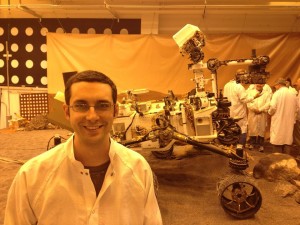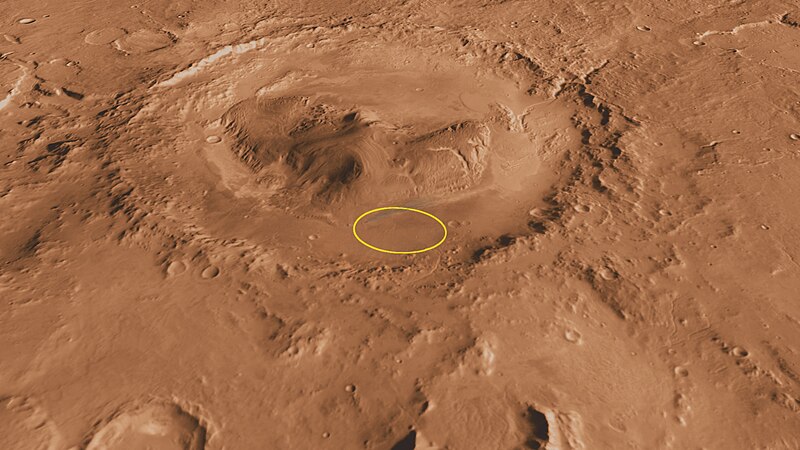There is now a video game where you can drive a rover around Mars! Other than exploring, which is awesome because the game uses real high-resolution imagery and topography data from Mars, there currently isn’t much to do. I want to change that and that’s what I’m talking about today. First, though, check the game out here.
Sometimes… maybe all the time, what makes a video game fun isn’t having unlimited power and resources, but having a limited amount of resources to accomplish your goal. In pretty much any game, and in real life, you have to work within a set of constraints… unless you’ve reached the “using money as a household rag” stage. I recently moved across the country to start a new job as a scientist working on the next Mars rover and so far I’ve found that not only is Mars exploration fun, but it can help to think like a gamer.

I’m standing in front of the new Xbox 720 prototype…. not really. Actually, that’s the Mars Science Laboratory testbed rover at the Jet Propulsion Laboratory in Pasadena, CA
The rover is called the Mars Science Laboratory and on August 5th, 2012 it will land in a big crater on Mars. The crater is named Gale, and in that crater there’s a mountain of layered rocks over 5 kilometers (18,000 feet) tall. Near the base geologists think the deposits are somewhere around 2 billion years old. These rocks formed a very long time ago when we know that Mars was a much different, and much more wet place, so we’re hoping to find some really interesting clues about what Mars was like when there was generally much more water around.

Gale crater, Mars. The rover will land somewhere in that yellow oval.
In the real-life game of exploring Mars, your own Mars Science Laboratory rover is the size of small car (think Mini-Cooper) loaded with a variety of scientific instruments that each tell you something different about the surrounding rocks and environment. Some of these instruments are mounted to the rover’s body and others can be deployed on an arm for up-close analysis. One of them, called the Alpha-Proton X-Ray Spectrometer or APXS, can tell you how much of a given element is in a rock. Very useful information! But you do have some trade-offs to consider… the instrument needs to be placed very close (not more than a few centimeters) to the sample. In order to move APXS into position you have to move the whole robotic arm, which weighs around 90 kg, so moving it takes a significant amount of power. APXS also requires a relatively large amount of time, several hours, to acquire enough statistical information to make meaningful conclusions about the abundances of the elements that are detected. But what it lacks in speed, it more than makes up for in the wealth of information gained about the elemental chemistry of the rocks and, as a bonus, the data can be stored in a relatively simple text file which can be transmitted back to Earth rapidly. So you’ll have to consider when to deploy and use the APXS strategically, as the science return can be great but it might take a significant amount of time and power. By contrast, another instrument called Dynamic Albedo of Neutrons (or DAN) can, within a matter on minutes, tell you the abundance of just one element, hydrogen. This instrument does not need to be deployed on the arm and its power usage is minimal. The data produced by DAN is also small, and similar to APXS, the data can be stored in text files. The advantage of DAN is that it can be used to accurately determine the abundance of hydrogen using very little power and data storage, but unlike APXS you are only getting information about hydrogen and not nearly the entire periodic table.

In video games and science, when in doubt, just blast everything with high powered lasers
OK, but say you don’t care about the composition of the rocks (what are you, some sort of physicist?) … well, your rover also has a variety of high resolution digital cameras, two on a mast that serve as the rover’s eyes and another mounted to the arm for close-up images. The cameras require relatively little power to focus and snap a picture, and the scientific return from the images can be invaluable… but what about the size of the data for all those pictures? If you want a full-size image to come back to Earth it could be around 2 Megabytes, which doesn’t sound like much but when you’re talking about getting that data back from Mars, along with all the required engineering and telemetry data, those images can add up. So you can scale-down the images and send back a lot of them each day, but the resolution may not be sufficient to get much scientific information. In order to accomplish your science goals, you have to choose carefully what full-size images get sent back to Earth. There are a bunch of other cool instruments on your rover and… I’m not even joking, one of them shoots laser beams! But rest assured, each instrument tells you something different about Mars, has it’s own set of power requirements, generates different amounts of data, and will take different amounts of time to operate.

“Should we fire the mass acceleration cannon, Jim?” “No, let’s do some sweet jumps first.” If only planetary exploration was really like driving the rover in Mass Effect…
Now lets get back to games. Games don’t teach us how to interpret geologic information returned from a Mars rover, and they don’t teach us how scientific instruments like APXS or DAN work, but if Mars exploration were a video game those wouldn’t be the “playable” parts of the game anyway. In this fictional game, interpreting the geologic history of Mars (or the history of ancient alien civilizations on Mars – whatever floats your boat) is the game’s story, it’s why you play, and you’d let the writers of the game dictate how that played out. The inner workings of how your scientific instruments work? Well, that’d be like asking how the assault rifle in Halo works or how pylons generate energy for the Protoss in Starcraft. Yes, it’s part of the game world, and it’s probably explained in one of the novels based on the game for players who are interested but it’s not central to much. What is central to the assault rifle in Halo or pylons in Starcraft? The answer is… what do they do? And in a game about Mars exploration, the answer is the same. What do your scientific instruments do? For the purposes of a game, gamers don’t care how these instruments (or guns) work, the important thing is what they do and in what situation one is preferable to another. Too often, video games that try to incorporate science get this very important part incorrect. They incorporate science at this level of detail, giving you explanations about the details of story components or explaining how details regarding your armor or weapons rely on scientific principles. While this method of incorporating science is commendable, it doesn’t engage the player or give them the feeling of really understanding. In a way, the science stays above the player, and talks down to them a bit. What I’m proposing is we give the scientific instruments and principles to the player, bring it to the level of actually using them while playing, and they’ll start to get comfortable with it. Even if you take some liberties to make it “fun”, it’ll go a long way to making people feel more comfortable with real science.

How does this pylon work? I don’t care, but it helps me obliterate hoards of zerg.
So in the game of Mars exploration, the fun is in how you do the exploring, what instruments you use, how you use them, and how you manage your resources. On top of this is a compelling story, graphics, and detailed background about the individual game elements. Playing the game would involve managing to discover new, amazing things on Mars under all the constraints you’ve been given. And as you can see, the constraints can be numerous, highly variable and (I think) fun! What’s especially fun is that there are multiple ways to solve problems. In the absence of any oversight whatsoever, you could accomplish the goals of Mars exploration by simply ignoring the constraints. Drill every rock! Take every picture!

You might be successful using this method but it will take you longer, you might wind up doing more than was necessary, you’ll use way more power, and if you use up too much time and resources, something unexpected might happen which may keep you from accomplishing your long term goal. There’s something fulfilling and fun about finding a more elegant solution to the problem. Gamers do this all the time, working with constraints and finding numerous, fun ways to play.
So with all this in mind, let’s get back to the Mars rover. There is one more “fun” constraint you have to work with. Consider that the seemingly simple act of getting data back from the rover is, in itself, determined by a process with it’s own set of advantages and limitations. We (humans) have several satellites in orbit around Mars, and we typically use one of them as a data relay between Earth and Mars for communication to the rover. This is great because it means we don’t have to store the data on the rover and we gain the ability to transmit relatively large quantities of data back to Earth. But, the limitation is that the satellite only passes over Gale crater twice a day, so all of the sending and receiving of data needs to be done during those two passes of the satellite over the rover’s landing site. And for added fun, you can only transmit so much data before the satellite passes over the horizon and you have to wait for the next pass… so you have to prioritize what comes down first, and if you don’t do it right, you might wind up sitting on Mars for an extra day without that critical piece of information you needed in order to move on. So effectively, you’re on the clock every day to make a science plan, command the rover to take the actions that complete the plan, wait for the rover to execute it, and then to evaluate the data that came back and start all over again. Go ahead and wrap all of these time constraints in another time constraint, which is that the rover itself, mechanically, has a limited lifetime.

Gamers are pretty familiar with managing a variety of resources… in this screenshot from World of Warcraft the bottom of the screen lists all the spells and abilities available, on the right side of the screen are all the quests the player is on, as for what’s on the left, who knows… it’s probably reminders to get up and eat a Hot Pocket every 7 hours
I described all of that stuff not only because I think it’s cool, but because it’s interesting to me that in Mars exploration and in games there are trade-offs. Engineers, who are probably facepalming, deal with trade-offs all the time. (Scientists… yeah, we’re aware of these things called trade-offs but they’re super inconvenient) Gamers, too, make choices about trade-offs in many strategy-based video games like Civilization and Starcraft. Role playing games like Star Wars: Knights of the Old Republic, World of Warcraft and Mass Effect also require a player to manage a variety of resources which have trade-offs. I’d also wager that a game set on Mars, focused on exploration with an intriguing story line would get the attention of a lot of gamers. And hey, I’m only partly kidding here… but what would work really well, and be cool, would be to implement this idea into a first-person shooter. Instead of shooting a gun, you have an infrared spectrometer, thermal imager, an APXS and a neutron detector… and, well sure, you can have a gun too. The closest we’ve come to this has been with a Portal gun, but there’s no reason why a bit more realistic of a scientific basis can’t be just as much fun as portal-based science.
—–
Update: Check this out! I had nothing to do with this whatsoever, but I’m really glad to see this type of thing on Xbox Live.
